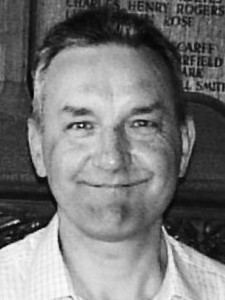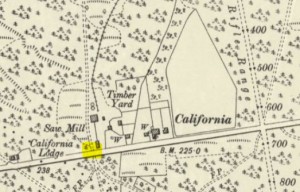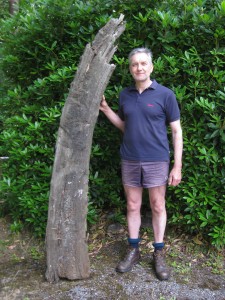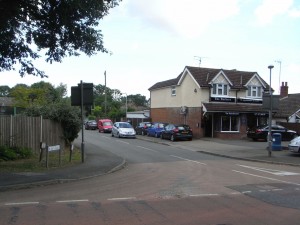 This week’s contributor is Trevor Ottlewski; researcher, author and Chairman of the Wokingham History Group. Trevor has a wide knowledge of local history and specialises in the area’s historic buildings. (This article originally appeared in the Wokingham Paper 24th July 2015).
This week’s contributor is Trevor Ottlewski; researcher, author and Chairman of the Wokingham History Group. Trevor has a wide knowledge of local history and specialises in the area’s historic buildings. (This article originally appeared in the Wokingham Paper 24th July 2015).
California in Berkshire
When most British people hear the name California, they think of California USA, and perhaps sunny beaches, Hollywood, or the gold rush, however there are some seven places named California in Great Britain.
In Berkshire, the name California refers to an area of land that runs alongside Nine Mile Ride; it is now wholly in the parish of Finchampstead, although in the past has had portions in Barkham, Wokingham and Wokingham Without. Defining the confines of California is not easy as it had no specific boundary; by the late 1850’s the name described the area around a brick yard and sawmill located in today’s terms at the Nine Mile Ride end of Kiln Ride, however some seventy years later it extended further west to California cross roads at the junction of Nine Mile Ride and Finchampstead Road, and then further still to California in England, the holiday camp.
The area of “California in England” had historically been Longmoor Bog and after the lake was formed, Longmoor Lake, the adoption of the name California seems only to have extended west with the new attraction. It is the latter feature, now a local country park that in most minds is the focus for the name California, albeit a mile or more away from the original site/centre of California.

That was then. The yellow dot on this 100 year old map shows the junction of Kiln Ride and Nine Mile Ride. (click to enlarge) ….
Why California? There is no definitive answer, but the most likely reason being an appreciation of California in America by one of its land owners; whether the subsequent planting of Wellingtonia (Sequoia) trees nearby in Finchampstead was deliberately intended to add to the character of California is not known, but they were a notable feature in California USA.
It would seem that the name California and the business arrived together in the early 1850’s; details are not clear regarding its original size, however by 1856 it had not only the brickyard and sawmill, but its own rail link, the California Tramway, that joined the main South Eastern and Chatham Railway line between Crowthorne and Wokingham, at California Junction. The original brickworks may have been located a little to the east of its eventual site, but by the early 1870’s it was firmly established with at least four kilns, two clay mills, a brickyard, sawmill and timber yard.
In addition there were 5 homes built for employees, one detached for the manager, and two semi detached. The houses remain to the present day and are among the very small number of 19th century buildings that were built on a virtually undeveloped Nine Mile Ride. Whilst the main tramway ran east from the kilns crossing Sandhurst Road and on to the main line, a further line ran from the brickworks to a clay pit at Wick Hill to assist in carrying clay to the clay mill.
The business was first in the hands of civil engineer and surveyor, Henry Read, but was soon incorporated into the huge Walter estate. It is reputed that bricks from this yard were taken by rail to London and used to construct The Times newspaper printing office.

 The other feature of note within California was a rifle range, this was sited east of the brickyard and was established by the 1870’s. Shooting was directed from south to north at which point there was a large target site cut into the hill with a signal post and hut. Distances were laid out in intervals of 50 yds, starting at 50 and reaching 650 close to the junction of range Road and Nine Mile Ride; by the 1890’s this had been extended to 950 yds by increasing the range across Nine Mile Ride (then a little used forest track), a situation hard to imagine today.
The other feature of note within California was a rifle range, this was sited east of the brickyard and was established by the 1870’s. Shooting was directed from south to north at which point there was a large target site cut into the hill with a signal post and hut. Distances were laid out in intervals of 50 yds, starting at 50 and reaching 650 close to the junction of range Road and Nine Mile Ride; by the 1890’s this had been extended to 950 yds by increasing the range across Nine Mile Ride (then a little used forest track), a situation hard to imagine today.
There was little change to the area until after the First World War, when throughout the 1920’s a steady stream of people moved to the area, many buying plots fronting Nine mile Ride, but also sites along other previously undeveloped roads; the plots were often narrow, but very long, probably because the price was based on the width of the frontage. California at this time described land on both sides of Nine mile Ride from the junction with Finchampstead Road, east to some point beyond Range Road. A huge number of bungalows were built, and in a wide variety of materials; timber, asbestos, breezeblock and brick were all in common use, and even today a few of these original buildings survive. Reputedly a lot of the incomers were ex servicemen and /or Londoners. The influx of new residents continued throughout the 1930’s and it could be argued has never stopped.
The development of shops and service station around 1930 moved the emphasis of California further west, and the establishment of the “California in England” amusement park and eventual holiday camp virtually relocated the name away from its original site, even the speedway team were known as the “California Poppies”.
The area now bears almost no resemblance to that of 100 years ago and for most people California is the name of a managed country park, its original history long forgotten.
The map below shows the area which was once a brickfield and rifle range called California. Click the bottom right icon for full size.
The map below shows the area which is now known as California Park. Just click on the arrow and watch the map change 100 years!



Have just read the above and am interested that you have one of the sleepers from the miniature railway. You may like to know that one of the original steam locomotives from the line is alive and well and resides only a few miles away! It was built in 1937 in Farnborough and has recently been restored. I have only one photo of the engine at California Park and would be delighted if you have any others.
I have a large collection of postcards of California-in-England. I would be very interested to see the locomotive. Any chance of a visit? I remember visiting Calinfornia as a child and playing on the rusted tracks of the original railway.
Our property is on the site of the sawmill a washroom facilities according to our deeds. Does anyone have any further details. Or can this be passed to Trevor to make contact?
Hi there, I live at 271 Nine Mile Ride- various evidence of former outbuildings in the garden, the last full-length one left! Great to read this- any idea when California Tramway went out of action?
Andy,
While researching my family tree and looking up maps of the area as my great-grandmother was possibly from the area, I found these maps that show the usage ended before the 1946 OS map:
It can be seen clearly on this 1876 map: https://maps.nls.uk/view/102340016
But has gone by the time of this 1946 map: https://maps.nls.uk/view/74466968
You can search through various maps of the area here: https://maps.nls.uk/geo/find/#zoom=13&lat=51.3737&lon=-0.8520&layers=102&b=1&point=51.3849,-0.8435
Hi, I actually carried out the interior design work on a project to resurrect California in (I think) the late 1970’s. An entrepreneur took over the virtually derelict building and gave me a budget of £200 to renovate the building! I was brought in at the last minute and was given 2 weeks to create atmosphere in the club (I had a LOT of energy in those days!) It was a large area and I filled it with Biba style 1930’s lady lamps and screen printed art deco patterns in gold on dark cork to renovate the table tops. I worked many hours, mostly on my own carrying out the work as well as designing and producing Litchenstein comic book style wallpaper for the 1950’s extension which became the dance area. The project wasn’t particularly successful as the areas were so large they couldn’t be filled, so people stopped going. Sadly the place was gutted by fire not long after it opened and all my work along with it! The 1930’s dance floor was plate glass and the part of the film the Virgin Soldiers was actually filmed there.
I was researching family history as my great-grandmother may well have lived on Sandhurst Road and found some maps that might be interest:
This one from 1876 shows the California Tramway in the upper right portion: https://maps.nls.uk/view/102340016
Side by side with a current Google maps satellite view, you can see where the curve of the track heading up towards the junction with the mainline would be with the current treeline: https://i.imgur.com/U8RiUCY.jpg
I remember visiting Little California in the mid 1950s on a Sunday School outing from West London. It was in a very rundown state. I remember calling out to a friend not to go down one of the tall slides, as it was broken off halfway down. There was nothing to stop you climbing the steps to the top. I seem to remember some of the other slides were in the same state. A Health and Safety nightmare these days.
Hi Judith. That’s a story! A slide broken halfway up, yikes. No amusements as before, but it’s night place for a walk and an excellent Full English. Pre- covid of course.
My father was one of the entertainment visitors called smokey the clown. It was back in 1956. The same time as the circus was there. He did a summer season there. Virginia McKenna and Richard Greene did a personal appearance there to promote the park that year too. I learnt to swim in the lake too that year. I was 9 years old. The Daily Sketch newspaper came and interviewed my dad too. He got my age wrong, much to my mums annoyance. He put me a year older. Now I cant wait to take a year off my age. 73. Anyway, I played with both Susan car ledge and her brother around the park during my stay there. My mum even made me go to the local school just at the end of the road. So that I didn’t miss any education. I enjoyed it there.it was wild, free and exciting.I doubt if there are many people still alive to remember my father. All the children that followed my dad around will all be my age now. Aaah. Good old days.
253 nine mile ride has unearthed a whole section of the train line at the bottom of their garden
Thanks for the comment. Are you able to share some details/Pictures? I have been researching this line. Thanks.
Hello Rob, can I email you?
I have some information on the tramway and brickworks if you are interested’
I have some information on this tramway.
My mum worked at California after the war. Mr Cartlidge was the owner at the time. Mum worked cleaning their house and then was in the kitchen.
I spent many hours there amusing myself, walking around the tiny zoo. There was a nasty monkey called “Jacko”.
The snake train was my favourite.
We lived at 269 NMR. I am now 81, so not many left that would remember all of my comments.
Hi Jill…this is a completely left field response to your Jacko memory. I did some research on the area’s bull baiting reputation which was a ‘sport’ interlaced with dog fighting. In London a monkey called Jacco (or Jacko) would fight the dogs in a pit. Vicious was not the word! Google Jacco Macacco if you want to read more, but be ready with the brandy!
I am now 82 as a child I went on a coach trip to California there was a big lake part of which was roped off as a swimming pool. The lake was full of big goldfish that also swam into the pool area. People were also fishing for the goldfish. I have always wanted to know where it was. The only other uk California is in Norfolk but I do not think that was it. Can anyone enlighten me on my lifetime search.
Hello Terry. Our California Park is definitely a possibility as it has a large lake in its grounds and was open to the public. I took my son fishing there regularly, but caught only perch. From memory, John Walter grew a number of Sequoia trees in his admiration of the huge forests throughout California USA. With the ’49 goldrush and it being something of a new frontier, California captured the imagination of many a young Englishman.